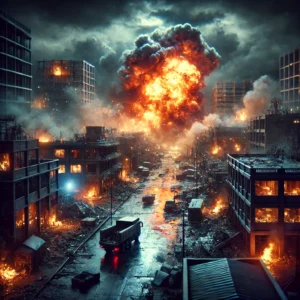
AI-Generated Video Purportedly Showing Fiery Aftermath of Israeli Airstrike in Beirut Goes Viral
An AI-generated video depicting the fiery aftermath of an Israeli airstrike in Beirut has gone viral on social media, sparking concerns about misinformation and the growing use of AI in generating realistic-looking, yet false, content. The video shows a dramatic scene of destruction, with towering flames and black smoke filling the skies of what is claimed to be the Lebanese capital. The clip was widely shared, gathering millions of views before experts pointed out that it had been artificially generated.
The Dangers of AI-Generated Content
The rapid spread of the AI-generated video raises critical questions about the role of artificial intelligence in media. AI technology is increasingly being used to create hyper-realistic content that can easily be mistaken for real footage. While this innovation has its benefits in certain creative fields, it also opens the door for misuse, as seen with the Beirut airstrike video. The realistic nature of these videos can mislead viewers, spreading disinformation and inflaming tensions, especially in sensitive regions like the Middle East.
Experts have already flagged the risks of AI-driven disinformation, with concerns that fake videos can be used to manipulate public opinion, influence political events, and incite unrest. In this case, the AI video of the Israeli airstrike could have easily been interpreted as an act of aggression, triggering heightened tensions between Lebanon and Israel. Such content underlines the urgent need for media literacy and awareness of AI’s capabilities.
How AI-Generated Videos Are Made
AI-generated videos are created using advanced techniques such as deep learning and generative adversarial networks (GANs). These algorithms can take real-life images, videos, or even just descriptions and turn them into realistic-looking footage. In the case of the Beirut airstrike video, AI may have been used to simulate explosions, debris, and environmental damage.
While these tools can be helpful for visual effects in films and creative projects, they also enable individuals to create deceptive content. As seen with the Beirut video, it’s not always immediately clear that the footage is fake, making it even more critical for social media platforms and content verification tools to be vigilant.
Combatting Misinformation in the Age of AI
As AI-generated content continues to evolve, fact-checking organizations and platforms like Facebook, Twitter, and YouTube are stepping up efforts to identify and remove such content. However, it’s a constant race between technological advancements in AI and the development of tools to combat disinformation.
It is crucial for viewers to be aware of the possibility that the videos they see online might not be what they seem. Learning to identify the hallmarks of AI-generated content, such as unnatural lighting or inconsistencies in textures, can help in distinguishing between real and fabricated footage. Additionally, cross-referencing news stories with credible sources and official media outlets can help verify the authenticity of viral clips.
The viral spread of the AI-generated video purportedly showing the aftermath of an Israeli airstrike in Beirut serves as a stark reminder of the power AI holds in shaping narratives. While the video turned out to be fabricated, its initial impact highlights the need for increased awareness and caution in consuming digital content. As technology continues to advance, distinguishing truth from fabrication becomes a vital skill for navigating the online world.
Visit our other website :pipwr.com



